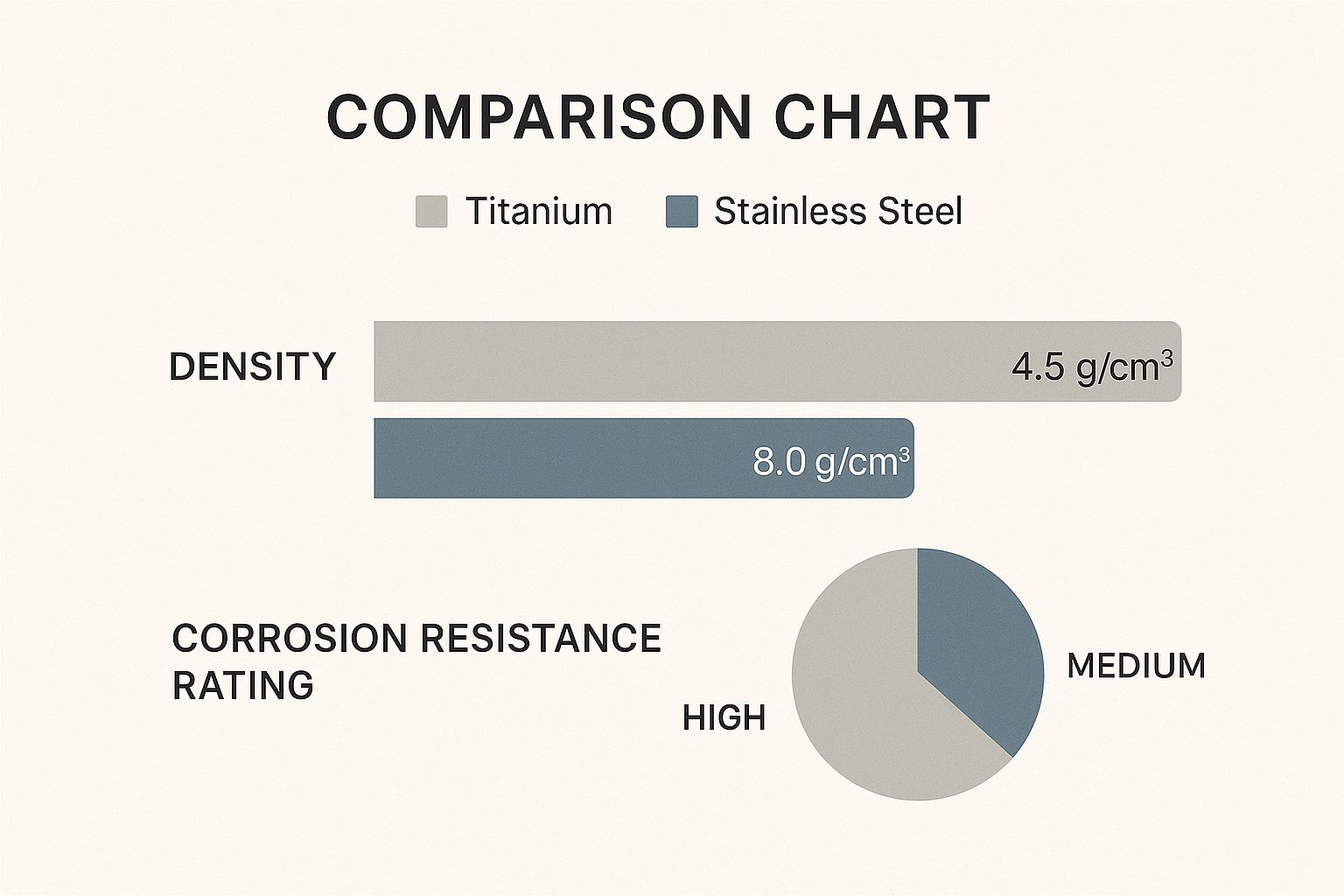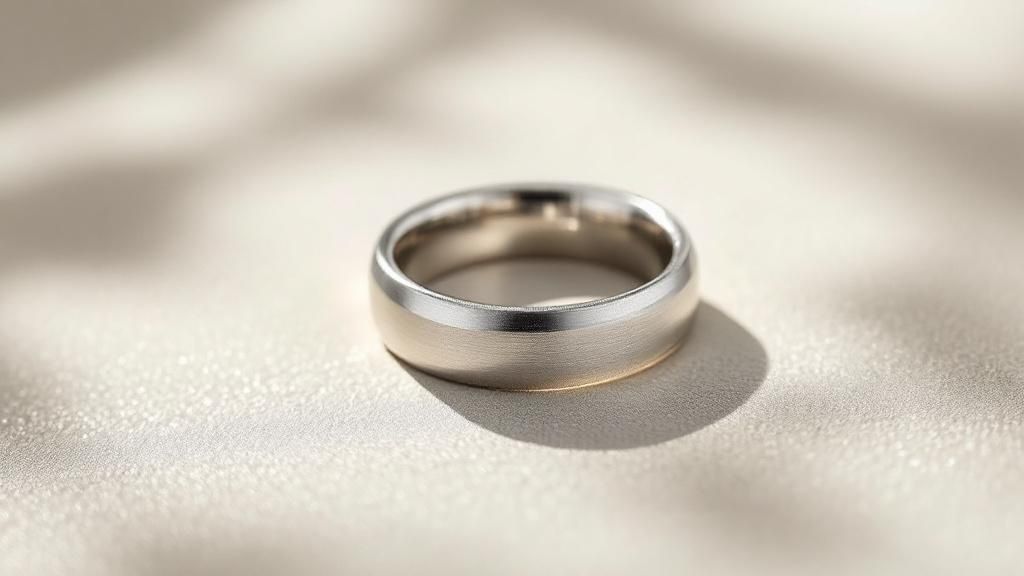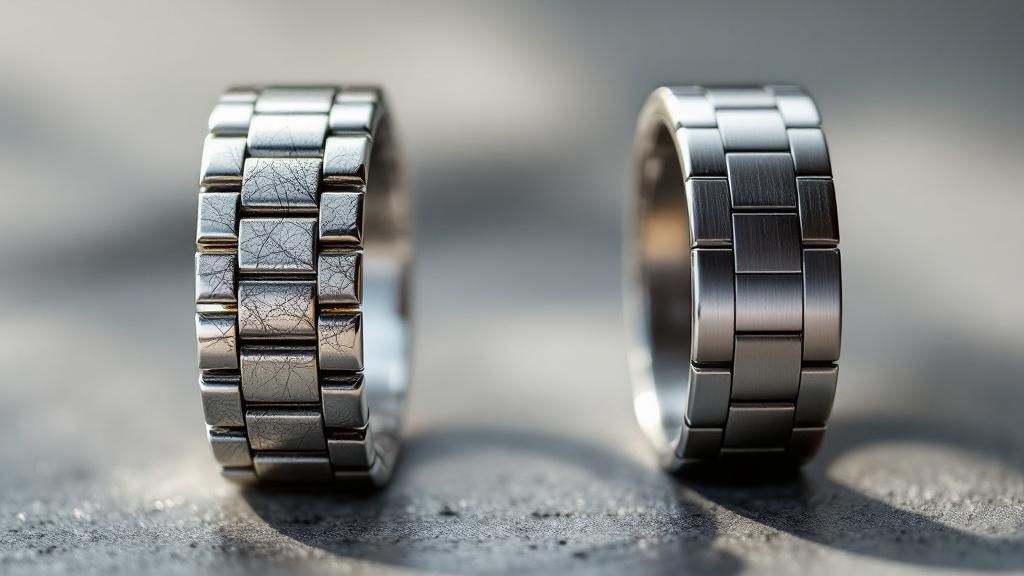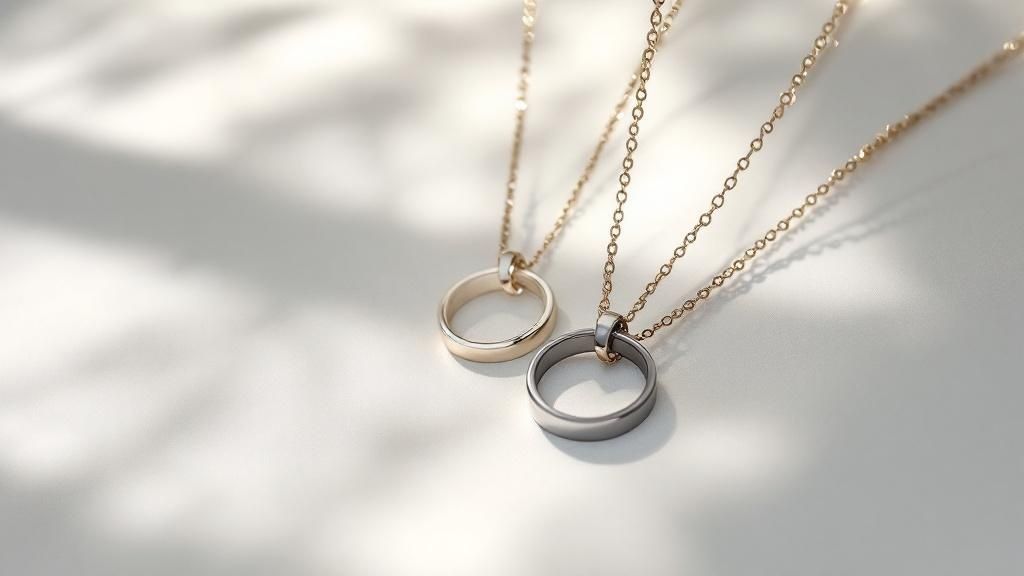Titanium vs Stainless Steel Jewelry A Complete Guide
- Luke Zucco
- Jul 18
- 12 min read
When you’re weighing your options between titanium and stainless steel jewelry, it really boils down to what you value most: comfort, toughness, or style. If you’re after something lightweight, completely hypoallergenic, and with a cool, modern vibe, titanium is almost certainly your best bet. On the other hand, if you love a brighter shine, a reassuringly heavy feel, and maximum affordability, then stainless steel is a brilliant all-rounder.
Your Guide to Choosing the Right Metal
Let's get past the basic pro/con lists. This guide is built on real-world experience to help you understand the subtle but important differences between these two metals. By looking at how each one holds up in day-to-day life, you'll be able to pick the one that truly fits your lifestyle and personal taste.
The choice often begins with the raw materials themselves. Titanium earns its praise for being incredibly strong—we’re talking aerospace-grade—yet feeling almost weightless on your skin. Stainless steel, in contrast, is known for that classic, solid feel and its impressive ability to fend off scratches.
Comparing Key Characteristics
Before we get into the nitty-gritty details, here's a quick side-by-side look to help you see how titanium and stainless steel compare on the factors that matter most.
Titanium vs Stainless Steel at a Glance
This table sums up the core characteristics of each metal, giving you a fast way to see which one might align better with your needs right from the start.
Feature | Titanium | Stainless Steel |
|---|---|---|
Weight & Comfort | Extremely lightweight; you'll barely notice it's there. | Heavier with a more substantial, traditional feel. |
Hypoallergenic | 100% biocompatible and nickel-free; perfect for sensitive skin. | Mostly hypoallergenic (like 316L), but contains trace nickel. |
Durability | Incredibly strong and dent-resistant, but can show scuffs over time. | Highly scratch-resistant, but can dent under a hard impact. |
Appearance | A modern, slightly darker gunmetal-grey shine. | A bright, silver-like luster, much like white gold or platinum. |
Cost | Generally more expensive due to raw material and machining costs. | Very affordable and a fantastic value for the price. |
After a quick glance, you can already see some clear trade-offs. Titanium is the champion of lightweight comfort, while stainless steel brings a classic look and feel at a friendlier price point.

This image really drives home a couple of key points. You can see that stainless steel is almost twice as dense as titanium, which is exactly why it feels so much heavier. At the same time, titanium pulls ahead with its superior resistance to corrosion.
Getting these fundamentals down is the first step. For more advice on making a smart purchase, check out our guide on **8 essential jewelry buying tips for 2025**. With this background, you're ready to dive deeper into how these metals perform in the real world.
Understanding the Jewelry Market Trends

To really get to the heart of the titanium vs. stainless steel debate, you have to look at where they stand in the broader jewelry market. Each metal has carved out its own dedicated following, and for good reason. Their distinct niches are a direct result of what people want, what technology allows, and what’s currently in style. This context is key to understanding why they’re priced and sold so differently.
Titanium jewelry is quickly becoming a favorite in the premium segment. It has a high-tech, almost futuristic feel, thanks to its roots in the aerospace industry where strength and low weight are everything. This reputation has attracted a new wave of buyers—people who want pieces that are minimalist, built to last, and, crucially, biocompatible.
On the other hand, stainless steel is an absolute giant in the market. It’s a powerhouse in the fashion jewelry scene, celebrated for its amazing value, classic silver-like shine, and incredible versatility. Because it's affordable and easy to work with, designers can churn out a massive variety of trendy, intricate pieces that just about anyone can afford.
Market Growth and Consumer Preferences
The way each metal's market is growing tells a fascinating story about what we value today. Titanium, which used to be a pretty niche choice, is now breaking into the mainstream. Why? Because more and more people are putting performance and personal wellness first when choosing their accessories.
The numbers back this up. The global titanium jewelry market, currently valued around USD 1.5 billion, is expected to more than double, hitting an estimated USD 3.2 billion by 2033. That’s a compound annual growth rate of about 9.2%, a surge driven by the demand for durable, sustainable jewelry. You can dive deeper into these market projections on Verified Market Reports.
Titanium's rise isn't just about being tough; it's a direct reflection of a cultural shift toward "buy it for life" products. People are more willing to invest in pieces that are hypoallergenic, won't rust, and are genuinely designed to last a lifetime.
Stainless steel’s strength in the market comes from a different place entirely: accessibility and endless style options. It gives people the freedom to play with the latest looks without breaking the bank. This has made it the engine of the fast-fashion jewelry world, where what's "in" can change from one season to the next. You can see how these regional trends evolve in our post on the hottest July jewelry trends in New York.
Ultimately, understanding the market makes the choice clearer. Titanium is the go-to for someone focused on high performance and biocompatibility. Stainless steel is the versatile, everyday choice for the style-savvy person who loves having options. One is an investment in personal comfort and modern engineering; the other is your ticket to expressive, affordable fashion.
How They Hold Up: Durability in the Real World
When you’re deciding between titanium and stainless steel jewelry, you have to think about how it will fare through the bumps, scrapes, and knocks of your daily life. This isn't just about which metal is "stronger"; it’s about what kind of durability matters most to you. Your job, your hobbies, even how clumsy you are—it all plays a part.
Titanium has a legendary reputation for its strength-to-weight ratio. It's incredibly tough and almost impossible to dent, which makes it a fantastic choice if you lead an active life. If you work with your hands or tend to bang your jewelry on countertops and door frames, a titanium ring will hold its shape beautifully against hard impacts.
But here’s the interesting part: for all its structural might, titanium's surface is actually softer than stainless steel's. This means it will pick up small scuffs and scratches from daily contact. Over time, these tiny marks can blend into a unique, soft-looking patina that many people love. But if you’re looking for a piece that stays perfectly polished, titanium might not be your best bet.
Scratch Resistance vs. Dent Resistance
This brings us to the core trade-off. Stainless steel, especially the 316L surgical grade you see everywhere, has a harder surface. That hardness makes it much more resistant to everyday scratches. For pieces like bracelets or watches that are always rubbing against desks, zippers, and keyboards, stainless steel will keep its shiny, polished look for a lot longer.
The flip side? While steel resists surface scratches, it's a more malleable metal. A hard, sharp impact can dent it. Drop a heavy steel ring on a ceramic tile floor, and you might see a permanent mark. That same drop probably wouldn’t faze a titanium ring at all.
Think of it this way: for resisting a serious drop or a hard blow, titanium is the undisputed champion. For fending off the countless tiny scratches of daily life, stainless steel comes out ahead.
One thing they both have in common is fantastic resistance to tarnish and corrosion. Feel free to wear either in the shower, the pool, or even the ocean. You won't have to worry about rust or discoloration, which is a huge part of what makes them so popular and easy to own.
The reliability of stainless steel is a big reason why its market is so massive. We're talking about a market valued at around USD 7.02 billion that's still growing. Its popularity comes from being affordable, versatile in design, and tough enough for real life. This combination makes it the default choice for stylish, durable accessories. You can dig deeper into this trend in this comprehensive stainless steel jewelry report.
So, when you choose, ask yourself what kind of "tough" you really need. If you're more worried about a piece getting bent out of shape or dented, titanium is your answer. If your biggest concern is keeping a flawless, scratch-free shine, then stainless steel is the more practical pick for the daily grind.
Which Metal Is Better for Sensitive Skin?

When you’re comparing titanium and stainless steel jewelry, skin sensitivity is often the deciding factor. For a lot of us, finding a hypoallergenic metal isn't just a preference—it's a must. This is where these two materials really part ways. The wrong choice can mean redness, itching, and general misery, turning a piece you love into one you can't wear.
If you have a known metal allergy or just really sensitive skin, the choice is pretty straightforward. Commercially pure and aircraft-grade titanium is 100% biocompatible. That’s a technical way of saying it’s completely nickel-free and designed not to react with the human body. It’s the definitive choice if you’ve ever had a bad reaction to other metals.
The Role of Nickel in Jewelry
So what’s the big deal with nickel? It's the primary culprit behind most metal allergies. It's a common alloy used to add durability and shine, but for a huge chunk of the population, it triggers contact dermatitis. This is where the differences between titanium and stainless steel become critically important.
Key Takeaway: Titanium is inherently nickel-free, making it the safest possible option for severe allergies. Stainless steel’s hypoallergenic status depends on how its nickel content is managed, making it suitable for most but not all.
Now, let's talk about surgical-grade stainless steel—specifically the 316L grade you see in quality jewelry. By industry standards, it's considered hypoallergenic. It does contain a small amount of nickel, but the magic is in the alloy's structure. The nickel is chemically bonded in a way that prevents it from leaching out and touching your skin, which is why it's safe for the vast majority of people.
But here’s the catch. For those with a severe nickel sensitivity, even that tiny, locked-in amount can sometimes be enough to cause a reaction. It's not common, but it’s a risk you simply don’t have with titanium. If you’ve ever reacted to a watch buckle or the button on your jeans, titanium is your guaranteed safe bet. You can learn more in our guide to the top hypoallergenic jewelry metals for sensitive skin.
Ultimately, your own experience is the best guide. If your skin is generally pretty tolerant, 316L stainless steel is a fantastic, safe, and budget-friendly option. But for absolute peace of mind and zero risk of a nickel flare-up, titanium wins every time.
3. Style, Aesthetics, and Cost
Beyond the practical stuff like durability and skin safety, the choice between titanium and stainless steel often comes down to two things: how it looks and how much it costs. These metals couldn't be more different in their vibe and feel, each hitting a sweet spot for a particular style and budget.
Titanium has a modern, almost futuristic look with its distinct gunmetal-grey shine. What really sets it apart, though, is how unbelievably light it is. You can wear a substantial titanium ring all day and practically forget it’s there, which is a huge plus for anyone not used to wearing jewelry.
Stainless steel, on the other hand, gives you that classic, bright-white metallic luster. It looks strikingly similar to pricier metals like white gold or platinum. It also has a satisfying heft to it—a substantial, traditional weight that many people associate with quality and value.
Visual Appeal and Design Versatility
The visual differences are just the start. The way each metal can be worked and finished opens up different doors for style and creativity.
One of the coolest things about titanium is its ability to be anodized. This process uses an electrical current to create a wild spectrum of colors right on the metal's surface—think vivid blues, deep purples, and fiery greens. This makes it the go-to choice for anyone wanting a truly unique, artistic piece that stands out.
Stainless steel's biggest strength is its classic, chameleon-like versatility. Its bright, reflective surface is a perfect backdrop for almost any design, from minimalist bands to intricate, detailed pieces. Since it does such a great job mimicking the appearance of precious metals, it's a staple for trendy, fashion-forward jewelry that won't break the bank.
The core properties of each metal really dictate where they fit in the market. Titanium’s higher price point is backed by its performance and unique aesthetic, making it a natural fit for high-end, modern designs. Stainless steel shines with its affordability and adaptability, allowing it to support a massive range of styles for fashion-focused buyers. You can learn more about how these materials meet market demands on HulkApps.com.
The Bottom Line on Your Budget
When it comes to price, the difference is night and day.
Titanium is the more expensive option, hands down. The raw material costs more, and it's tougher to work with, requiring specialized tools and techniques. This positions it as a premium alternative metal, ideal for a "forever" piece like a wedding ring where you’re making a long-term investment.
Meanwhile, stainless steel is the undisputed king of affordability. It delivers a high-end look and impressive durability for a tiny fraction of the cost. This makes it perfect for building out a diverse jewelry collection, trying out new trends without commitment, or simply finding a great-looking piece when you're on a tight budget.
Final Verdict: Which Metal Is Right for You?

So, after weighing everything, which metal comes out on top? The truth is, there's no single winner in the "titanium vs. stainless steel jewelry" showdown. The best choice really boils down to you—your lifestyle, your skin, and what you’re looking for in a piece of jewelry.
Instead of declaring one metal superior, let’s look at this practically. We’ve broken down the durability, hypoallergenic properties, style, and cost. Now, let’s put that information to work with some real-world scenarios to help you decide.
Choose Titanium Jewelry
Think of titanium as the high-performance, specialist metal. It’s the go-to when specific needs like biocompatibility and a lightweight feel are the top priority.
You Have Severe Metal Allergies: If you have extremely sensitive skin or a known nickel allergy, this is an easy decision. Titanium is 100% biocompatible, which means there's virtually no risk of it causing a reaction. It's the ultimate peace-of-mind metal.
You Lead an Active Lifestyle: Are you an athlete, a builder, or just someone who is tough on their jewelry? Titanium's remarkable strength and resistance to denting mean it will stand up to almost anything you throw at it.
You Can't Stand Heavy Jewelry: If the weighty feeling of a ring or bracelet bothers you, titanium will feel like a revelation. It's so incredibly light that you’ll often forget you're even wearing it, making it perfect for pieces you never take off, like a wedding band.
If you're someone who values cutting-edge engineering, minimalist aesthetics, and absolute skin safety, titanium is your clear winner. It’s a fantastic long-term investment.
Choose Stainless Steel Jewelry
Stainless steel is the versatile, everyday champion. It's the perfect blend of classic style, solid performance, and incredible value, making it a favorite for a reason.
You’re Shopping on a Budget: This is where stainless steel truly shines. It gives you that polished, premium look and impressive durability without the hefty price tag. It's the ideal way to build out a stylish jewelry collection affordably.
You Love That Classic, Bright Shine: If you’re after the bright, cool luster of white gold or platinum but not the cost, surgical-grade stainless steel is an excellent substitute. It has a timeless appeal that works with any style.
You Like to Keep Up with Trends: Because it’s so affordable, stainless steel gives you the freedom to experiment. Go ahead and buy that bold statement necklace or chunky bracelet you’ve been eyeing. You can try out new trends without making a major financial commitment.
Frequently Asked Questions
When you're trying to decide between titanium and stainless steel jewelry, it's the practical, day-to-day questions that often make the difference. Knowing how each metal handles real-life situations, from resizing a ring to simply cleaning it, will help you pick the one that truly suits you. Let's tackle the most common questions people ask.
Can Titanium Rings Be Resized?
This is a big one, and it's a critical point for anyone buying a ring. The short answer is: almost never. Titanium's incredible strength, which makes it so durable, also means it's a nightmare for jewelers to work with. Cutting, stretching, or shrinking a titanium band requires highly specialized equipment that most shops just don't have.
Because of this, you absolutely have to get your ring size right from the start. I always tell customers to get sized by a professional jeweler—maybe even at two different times of day to see how your finger naturally swells and shrinks. When you buy titanium, you're buying it for keeps at that exact size.
Which Metal Is Heavier?
You'll feel the difference the moment you hold them. Stainless steel is a much denser metal, giving it that classic, substantial weight you might expect from a quality piece of jewelry. A stainless steel watch, for instance, has a reassuring heft on the wrist that many people love.
Titanium is the complete opposite. It's so light that it's almost startling. A titanium ring of the same size and shape as a steel one can feel like it's barely there. If you're someone who finds heavy jewelry annoying or gets in the way of your active lifestyle, titanium is your best bet for pure comfort.
Key Insight: The weight isn't just a small detail; it fundamentally changes how the jewelry feels to wear. Stainless steel offers a solid, traditional presence, while titanium provides an almost weightless experience perfect for someone who wants to forget they're even wearing it.
How Do You Clean Titanium and Stainless Steel Jewelry?
Here's the good news: both of these metals are incredibly easy to care for. You can forget about special polishes or pricey cleaning solutions. Both are built to resist tarnish, rust, and corrosion, so keeping them looking sharp is a breeze.
For a quick, routine clean-up, a simple method works perfectly for both:
Make a simple cleaning solution: Just mix a few drops of mild dish soap into a bowl of warm water.
Gently scrub: Use a soft cloth or a soft-bristled toothbrush to gently clean the piece. Pay a little extra attention to any nooks and crannies where dirt might be hiding.
Rinse and dry: Run it under clean water to rinse off the soap, then dry it completely with a soft, lint-free cloth. This prevents any water spots from forming.
That’s all it takes. This simple routine will cut through everyday grime and body oils, bringing back your jewelry’s shine without any hassle.
At Panther De Luxe, we believe great jewelry should look amazing and fit into your real life. Take a look at our collections of premium titanium and stainless steel to find the piece that feels like it was made just for you.

Comments